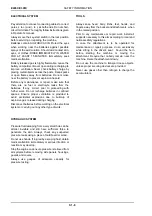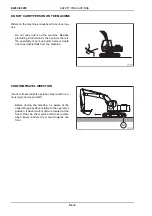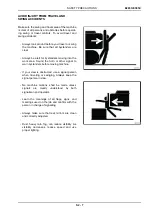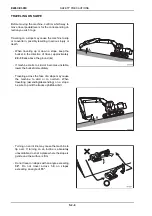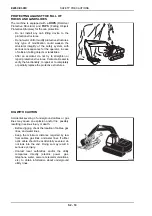
S1 - 3
SAFETY INFORMATION
E265C-E305C
likely to be concealed by bushes, undergrowth and
such.
Avoid bushes, logs and rocks. Never drive over them,
nor over any other surface irregularities that
discontinue adherence or traction with the ground,
especially near slopes or drop-offs.
Be alert to avoid changes in adherence conditions
that could cause loss of control. Work with extreme
care on ice or frozen ground and on stepped slopes
or near drop-offs.
The word “bulldozing” generally refers to work in
virgin rough terrain, characterised by the presence of
all the perils and risks listed above. We emphasise
the danger represented in these conditions by large
tree limbs (possibly falling on the machine) and large
roots (which may act as a leverage under the
machine when up-rooted and cause the unit to
overturn).
Position the machine dependent upon the loading
and unloading areas in order to swing leftwards to
load to obtain best visibility.
Never use the bucket or attachment as a man lift or
carry riders. Never use the machine as a work
platform or scaffolding. The machine must not be
improperly used for works not consistent with its
features (such as pushing railway cars, trucks or
other machines).
Always pay attention to people within the machine
operating range.
Never move or stop the bucket, other loads or the
attachment above ground personnel or truck cabs.
Ensure the truck driver is in a safe place before
loading the truck.
Load trucks from side or rear.
Use only the type of bucket recommended
considering machine type, materials to be handled,
material piling up and loading characteristics, ground
type and other typical conditions of the work to be
performed.
When transporting a loaded bucket, keep it as
rolled-back as possible. Keep boom and arm as low
as possible.
Ground speed should be adequate to the load and
ground conditions.
The load must always be properly arranged in the
bucket; move with extreme care when transporting
oversize loads.
Do not lift and move the bucket overhead where
persons are standing or working, nor downhill when
working on a slope as this would decrease machine
stability. Load the bucket from the uphill side.
Loads to be raised using the machine should be
exclusively hooked to the hitch specially provided.
The excavator is no lifting and transportation means,
therefore it should not be used to position loads
accurately. Should it be exceptionally used to lift and
lay building components, special caution must be
taken as follows:
- The machine must be equipped compulsorily with
the appropriate variant provided upon request.
- Secure the loads to be raised using cables or
chains fastened with appropriate hooking
mechanisms.
- Nobody should be allowed to remain under the
raised load or within the excavator operating range
for any reason whatever.
Never exceed specified loading capacity. Incorrect
fastening of slings or chains may cause boom/arm
failure or failure of the lifting means with consequent
bodily injuries and even death.
Always ensure that slings and chains used for lifting
are adequate to the load and in good condition.
All loading capacities are referred to the machine on
a level surface and should be disregarded when
working on a slope.
Avoid travelling across slopes. Proceed from uphill
downhill and vice-versa. If machine starts slipping
sideways when on a slope, lower the bucket and
thrust bucket teeth into the ground.
Working on slopes is dangerous. Grade the working
area if possible. Reduce work cycle time if it is not
possible to grade the working area.
Do not move full bucket or a load from uphill downhill
as this would reduce machine stability. Do not work
with the bucket turned to the uphill side.
Do not work with the bucket turned uphill as
counterweights protruding downhill would reduce
machine stability on the slope and increase risk of
overturning.
We recommend to work on slopes with the bucket
downhill, after checking machine stability with the
bucket empty and attachment retracted, by slowly
swinging the upper structure by 360°.
Position the carriage at a right angle relative to
slopes, hanging walls, etc. to exit the working area
easily.
Keep the machine sufficiently far from the ditch
edge.
Never dig under the machine.
Should it be necessary to dig under the machine,
always ensure that digging walls are opportunely
propped up against landslide to prevent the machine
from falling into the trench.
Do not swing the upperstructure, raise the load or
brake abruptly if not required. This may cause
accidents.
Prior to beginning the work near gas distribution
mains or other public utilities:



















